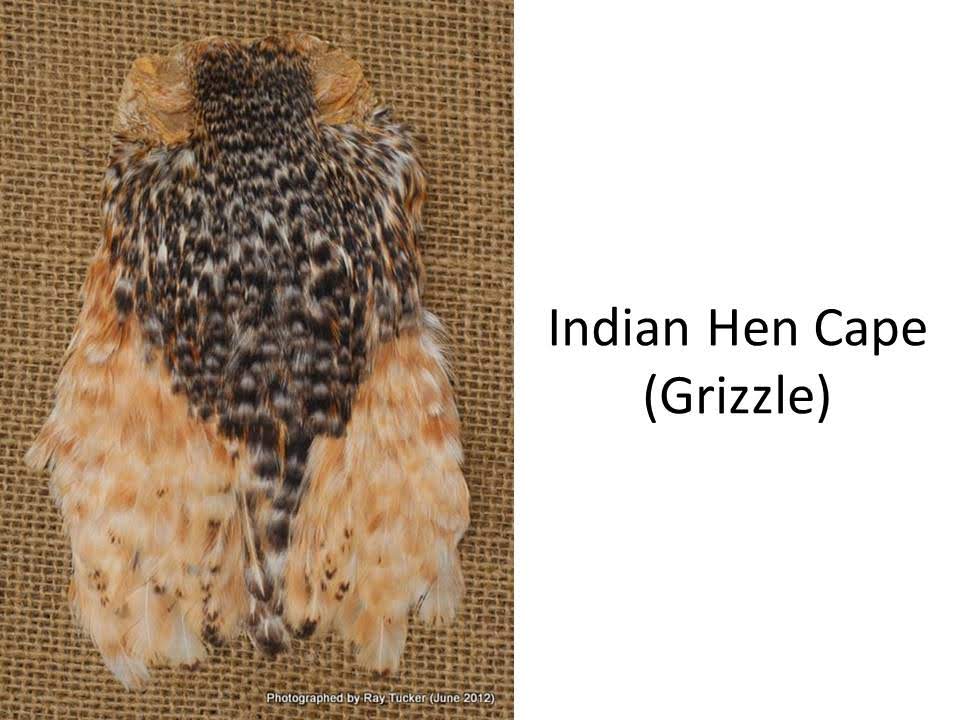Indian Hen Skins - Reference Photos - Inexpensive Hackle
Moderators: William Anderson, letumgo
- letumgo
- Site Admin
- Posts: 13346
- Joined: Sat Feb 21, 2009 7:55 pm
- Location: Buffalo, New York
- Contact:
Indian Hen Skins - Reference Photos - Inexpensive Hackle
Indian Hen Skins are an inexpensive source of soft hackle feathers. I bought these from Jim Slattery a couple years ago,and I think they were around $5 dollars per neck. Anyone just starting out, tying soft hackle flies would do to give Indian hen necks a try.





Ray (letumgo)----<°))))))><
http://www.flytyingforum.com/index.php? ... er=letumgo
"The world is perfect. Appreciate the details." - Dean
http://www.flytyingforum.com/index.php? ... er=letumgo
"The world is perfect. Appreciate the details." - Dean
Re: Indian Hen Skins - Reference Photos - Inexpensive Hackle
Nice looking pelts, Ray. Unfortunately for me, I have found that the several Indian hen skins I have purchased over the years have provided precious few feathers that I could use on smaller flies (Size #14 and smaller). But perhaps I just got some inferior skins?
I would appreciate hearing from others about their experiences with these feathers.
I would appreciate hearing from others about their experiences with these feathers.
Some of the same morons who throw their trash around in National parks also vote. That alone would explain the state of American politics. ~ John Gierach, "Still Life with Brook Trout"
- letumgo
- Site Admin
- Posts: 13346
- Joined: Sat Feb 21, 2009 7:55 pm
- Location: Buffalo, New York
- Contact:
Re: Indian Hen Skins - Reference Photos - Inexpensive Hackle
I just realized that all of my photos are miss labeled as "capes". These are all hen necks, not capes.  The neck feathers tend to be somewhat smaller and offer a broader range of hackle sizes.
The neck feathers tend to be somewhat smaller and offer a broader range of hackle sizes.
Ray (letumgo)----<°))))))><
http://www.flytyingforum.com/index.php? ... er=letumgo
"The world is perfect. Appreciate the details." - Dean
http://www.flytyingforum.com/index.php? ... er=letumgo
"The world is perfect. Appreciate the details." - Dean
Re: Indian Hen Skins - Reference Photos - Inexpensive Hackle
Are capes not necks?
- letumgo
- Site Admin
- Posts: 13346
- Joined: Sat Feb 21, 2009 7:55 pm
- Location: Buffalo, New York
- Contact:
Re: Indian Hen Skins - Reference Photos - Inexpensive Hackle
Trifly - I believe capes are along the back of the bird, while necks are from the region below the chin of the bird. Roughly from the chin down to the middle of the belly. I think of capes and saddles being similar terms, for the back region of the bird. Then again, I could be wrong.
Hopefully someone else will chime in with a better answer.
Hopefully someone else will chime in with a better answer.
Ray (letumgo)----<°))))))><
http://www.flytyingforum.com/index.php? ... er=letumgo
"The world is perfect. Appreciate the details." - Dean
http://www.flytyingforum.com/index.php? ... er=letumgo
"The world is perfect. Appreciate the details." - Dean
Re: Indian Hen Skins - Reference Photos - Inexpensive Hackle
Capes and necks are the same item. Both are skinned off the bird from the back of the birds head down to its wings.
The illustration shows where the necks were skinned starting at the head. Check your Whiting hen capes. You will see they are the same.
- Attachments
-
- 20181021_084157.jpg (93.26 KiB) Viewed 2723 times
-
- 20181021_084119.jpg (96.61 KiB) Viewed 2723 times
- letumgo
- Site Admin
- Posts: 13346
- Joined: Sat Feb 21, 2009 7:55 pm
- Location: Buffalo, New York
- Contact:
Re: Indian Hen Skins - Reference Photos - Inexpensive Hackle
Thanks you for marking up the photos. This is helpful in pointing out the location of the smaller feathers, in the region near the birds head.
I was able to find another reference, which confirms your comment/feedback.
WEB LINK: Raising Chickens: click here ----> https://globalflyfisher.com/tie-better/raising-chickens



WEB LINK: Preserving Feathers: click here ----> https://globalflyfisher.com/tie-better/ ... g-feathers
I was able to find another reference, which confirms your comment/feedback.
WEB LINK: Raising Chickens: click here ----> https://globalflyfisher.com/tie-better/raising-chickens



WEB LINK: Preserving Feathers: click here ----> https://globalflyfisher.com/tie-better/ ... g-feathers
Ray (letumgo)----<°))))))><
http://www.flytyingforum.com/index.php? ... er=letumgo
"The world is perfect. Appreciate the details." - Dean
http://www.flytyingforum.com/index.php? ... er=letumgo
"The world is perfect. Appreciate the details." - Dean
